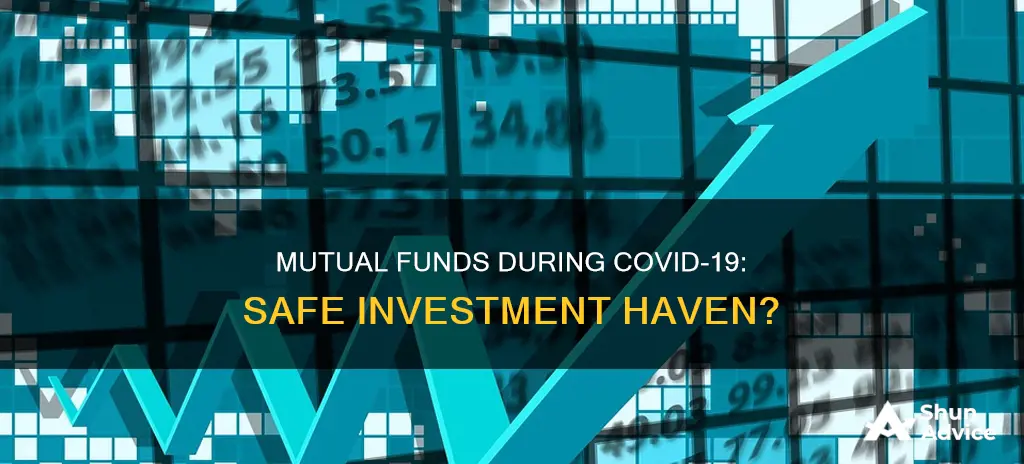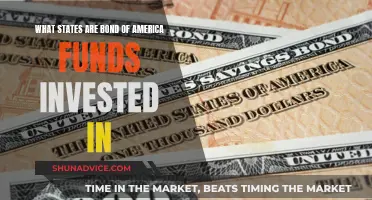
The COVID-19 pandemic has had a significant impact on the performance of mutual funds, with many active funds underperforming passive benchmarks. However, funds with high sustainability ratings have performed well, indicating that investors view sustainability as a necessity rather than a luxury. The pandemic has also led to concerns about the safety of investing in mutual funds, especially with the closure of several debt mutual funds. This has resulted in a growing preference for capital preservation over capital appreciation. So, is it safe to invest in mutual funds during COVID-19?
What You'll Learn

Active funds underperformed passive benchmarks
While it is challenging to determine if investing in mutual funds during COVID-19 is safe, here is some information on the performance of active and passive funds.
During the COVID-19 crisis, most active funds underperformed passive benchmarks, contrary to a popular hypothesis. This trend aligns with the broader pattern of active fund managers struggling to outperform their benchmarks over the medium and long term.
The S&P Global Inc.'s SPIVA (S&P Index Versus Active) Canada Scorecard, which covers the period ending June 30, 2022, reinforces this observation. It shows that most active managers have consistently underperformed their benchmarks over one-, three-, five-, and ten-year periods.
Similarly, the S&P Indices Versus Active Scorecard (SPIVA) for the year ended December 31, 2019, indicates that 70% of domestic equity funds lagged behind the S&P Composite 1500, making it the fourth-worst performance since 2001. Large-cap fund managers had a particularly notable streak, with 71% underperforming the S&P 500 for ten consecutive years.
The underperformance of active funds can be attributed to various factors, including higher fees, higher volatility, and the challenge of consistently outperforming the market. The costs of running actively managed funds are generally higher than those of passive funds, leading to higher management fees. While higher fees should not be an issue if active managers can generate higher returns to offset them, they have largely failed to do so.
The shift towards passive investing, particularly exchange-traded funds (ETFs), further highlights the challenges faced by active fund managers. ETFs have gained popularity due to their lower fees and the ability to mimic a given index, such as the S&P 500.
However, it is worth noting that a small percentage of active managers have succeeded in outperforming their benchmarks and comparable ETFs. Despite the overall trend, there are still some active funds that have produced superior results, demonstrating the potential for active management to add value under certain conditions.
In summary, while active funds have generally underperformed passive benchmarks, there are exceptions, and investors should carefully evaluate their investment choices based on their specific circumstances and goals.
IRA Mutual Fund Investment: A Comprehensive Guide
You may want to see also

Funds with high sustainability ratings perform well
According to a comprehensive analysis of the performance and flows of US actively managed equity mutual funds during the 2020 COVID-19 crisis, funds with high sustainability ratings performed well. This contradicts a popular hypothesis that most active funds underperform passive benchmarks during a crisis.
The analysis also found that investors favoured funds that applied exclusion criteria and funds with high sustainability ratings, especially those with an environmental focus. This suggests that investors view sustainability as a necessity rather than a luxury good.
ESG stands for environmental, social, and governance. ESG funds are investments that are graded using these principles. They invest in companies that aim to have a sustainable and societal impact in the world, such as those with a small carbon footprint or diverse leadership boards.
Examples of ESG funds
- Franklin Responsibly Sourced Gold ETF
- Procure Disaster Recovery Strategy ETF
- Putnam Sustainable Leaders ETF
- JPMorgan Active Growth ETF
- IShares ESG Advanced MSCI USA ETF
- ClearBridge Large Cap Growth ESG ETF
- American Century Mid Cap Growth Impact ETF
- Vanguard ESG U.S. Stock ETF
- Pimco Enhanced Short Maturity Active ESG ETF
- Nuveen ESG Dividend ETF
- IShares MSCI Global Sustainable Developmental Goals ETF
- Fidelity U.S. Sustainability Index Fund
- Fidelity International Sustainability Index Fund
- Calvert US Mid Cap Core Responsible Index Fund
- BlackRock Sustainable Advantage CoreAlpha Bond Fund
How to choose an ESG fund
When choosing an ESG fund, it is important to consider the following:
- Define your ESG focus: Are you primarily focused on environmental issues, or are positive social outcomes your greatest concern?
- Research ESG fund strategies: Funds employ a range of strategies, such as positive screening to actively select companies with strong ESG performance, or negative screening to exclude companies involved in controversial activities.
- Understand ESG criteria: There is no universal standard for all ESG criteria, so it is important to understand what metrics your target funds are employing.
- Evaluate the fund's track record: Review the fund's historical performance, keeping in mind that past performance does not indicate future results.
- Consider fees and costs: ESG funds are known for having higher expense ratios than other types of funds, so compare the fees associated with your fund to ensure you are minimising costs.
- Seek out independent ratings and certifications: Consider independent ratings and certifications provided by organisations such as Morningstar, MSCI, or the United Nations-supported Principles for Responsible Investment (PRI).
It is essential to conduct thorough research and due diligence to choose an ESG fund that aligns with your values, investment objectives, and risk tolerance.
Protecting Your Investment Funds: Lawsuit Shield Strategies
You may want to see also

Capital preservation is more important than capital appreciation
Investing in mutual funds during the COVID-19 pandemic is a complex decision that depends on various factors, including your financial goals, risk tolerance, and investment horizon. While it is challenging to provide a definitive answer, understanding the concept of capital preservation versus capital appreciation can guide your investment strategy. Here are some paragraphs discussing why capital preservation is more important than capital appreciation:
Paragraph 1:
The COVID-19 pandemic has caused significant economic uncertainty, making capital preservation a priority for many investors. Capital preservation refers to an investment strategy that focuses on maintaining the initial value of an investment and minimizing potential losses. This approach is particularly relevant during times of economic crisis, such as the COVID-19 pandemic, when preserving one's financial stability becomes crucial. By prioritizing capital preservation, investors can safeguard their principal investment and reduce the risk of incurring substantial losses. This strategy is especially suitable for individuals with a low-risk tolerance or those approaching retirement, as they may have limited time to recoup any losses.
Paragraph 2:
During the COVID-19 pandemic, market volatility and economic downturns increased the risk of capital loss. In such uncertain times, preserving capital becomes essential to ensure that investors do not incur significant financial setbacks. Capital preservation strategies involve investing in low-risk assets, such as government bonds, FDIC-insured accounts, money market funds, and short-term instruments like Treasury bills and certificates of deposit. These investments provide stability and security, ensuring that investors' principal amounts remain relatively safe. While the returns may be smaller compared to riskier investments, capital preservation helps protect against the potential for large losses.
Paragraph 3:
The impact of the COVID-19 crisis on financial markets has been significant, with many funds underperforming and investors experiencing losses. In such a volatile environment, capital preservation becomes a more realistic and prudent goal than capital appreciation. By focusing on capital preservation, investors can aim to maintain the purchasing power of their investments by at least matching the rate of inflation. This is crucial, as high inflation rates during economic crises can erode the real value of investments over time. While capital appreciation strategies aim for higher returns, they also carry a higher risk of loss, which may not be suitable for investors during the pandemic.
Paragraph 4:
The COVID-19 pandemic has caused job losses, balance sheet stress, and volatile equity markets, making capital preservation a more critical priority than capital appreciation. Investors are seeking safe investment options to weather the economic storm. Certain debt instruments, such as AAA-rated corporate bonds, fixed savings schemes offered by governments, and low-risk debt funds, have become attractive options for capital preservation. These instruments provide a more stable alternative to riskier investments, helping investors protect their capital during uncertain times. While capital appreciation strategies may offer higher returns, they also carry a higher risk of loss, which may not be a viable option for those seeking to preserve their financial stability during the pandemic.
Paragraph 5:
During the COVID-19 pandemic, it is essential to consider the potential impact of market downturns and economic uncertainty. Capital preservation strategies allow investors to minimize the effects of market fluctuations and provide a safety net for their capital. By investing in a diverse range of low-risk assets and adopting risk management techniques, investors can protect their principal investments. While capital appreciation strategies aim for higher returns, they often carry a higher level of risk, which may not be suitable for those seeking to preserve their capital during the pandemic. Therefore, prioritizing capital preservation over capital appreciation can be a wise decision to navigate the financial challenges posed by COVID-19.
Arbitrage Funds: A Smart Investment Strategy for Savvy Investors
You may want to see also

Avoid debt instruments with substantial credit risk
When it comes to investing in mutual funds during the COVID-19 pandemic, it is important to exercise caution and construct a robust debt portfolio. One key aspect to consider is avoiding debt instruments with substantial credit risk. Here's why this is crucial and how you can navigate this aspect of investing:
Understanding Credit Risk
Firstly, it is essential to understand what credit risk entails. Credit risk refers to the possibility of loss due to a borrower's failure to repay a loan or meet their contractual obligations. In the context of debt instruments, credit risk is associated with the potential default of the issuer, resulting in losses for investors. Credit risk is an essential factor in assessing the safety of debt investments.
Impact of COVID-19 on Credit Risk
The COVID-19 pandemic has had far-reaching economic consequences, and the credit risk environment has been significantly impacted. The pandemic has led to a decline in economic activities, affecting the financial health of many companies. As a result, the risk of default for some issuers has increased, and previously assigned credit ratings may no longer be accurate. This dynamic situation calls for extra caution when investing in debt instruments.
Assessing Creditworthiness
When considering debt instruments, it is crucial to assess the creditworthiness of the issuer. Credit ratings assigned by reputable rating agencies provide valuable insights. Generally, higher credit ratings indicate lower credit risk and higher creditworthiness. However, it's important to remember that credit ratings are dynamic and can change over time due to various macro and microeconomic factors. Therefore, staying updated with the latest credit ratings and being vigilant about any downgrades is essential.
Avoiding Substantial Credit Risk
To protect your investments, it is advisable to avoid debt instruments with substantial credit risk during the COVID-19 pandemic. This includes instruments such as credit risk funds, dynamic bond funds, arbitrage funds, gilt funds, hybrid funds, and certain bank fixed deposits. Instead, focus on debt instruments with strong credit ratings, such as AAA-rated corporate bonds or government-backed fixed income instruments. These options typically offer more security and lower default risk.
Diversification and Safety
Diversification is a key strategy to manage credit risk. Spread your investments across different debt instruments and issuers to reduce the impact of any single default. Additionally, prioritize safety over returns, especially during these uncertain times. Opt for debt instruments backed by reliable collateral or those with strong credit ratings. Remember, capital preservation should be a primary goal during economic downturns.
Stay Informed and Adapt
Stay informed about the latest economic trends and the performance of debt instruments. Regularly review your debt portfolio and be prepared to make adjustments. If you notice a downward revision in the credit rating of a debt instrument you've invested in, reevaluate your position and consider alternatives. Being proactive and responsive to market changes can help safeguard your investments.
In summary, when investing in mutual funds during the COVID-19 pandemic, steering clear of debt instruments with substantial credit risk is a prudent strategy. By understanding credit risk, assessing creditworthiness, diversifying your investments, prioritizing safety, and staying informed, you can make more informed decisions and protect your financial interests. Remember, while investing in debt instruments can provide significant benefits, it's essential to be cautious and thorough in your assessments during these challenging economic times.
A Beginner's Guide to Index Fund Investing in India
You may want to see also

ESG fund flows remained stable during the crisis
During the COVID-19 crisis, ESG funds managed by French asset managers demonstrated resilience and outperformed their peers, benefiting from stronger inflows. This trend was observed across different investment zones, including France, Europe, and the World, and regardless of the performance achieved. The top-rated equity funds saw inflows of 2.5% of their aggregate assets under management at the end of 2019, while lower-rated funds experienced outflows of 5.8%.
The best-rated European large-cap funds outperformed their benchmark by 3.1% over the period under review, compared to -0.9% for the least virtuous in terms of ESG. This outperformance was achieved at comparable risk levels, as indicated by the analysis of the information ratio of the ESG funds, which was significantly higher than that of the poorly ranked funds. The volatility of European large-cap equity funds was also lower in the first half of 2020 for the most sustainable funds, a difference not observed in the past.
The ability of ESG funds to demonstrate resilience during a period of severe market turbulence and significant volatility highlights the potential for asset managers to integrate ESG criteria to remain competitive while ensuring a certain level of resilience during a crisis. Implementing the right strategy, operating model, procedures, and data sources will be key for asset managers to become credible ESG fund providers and maintain a competitive edge in the future.
Overall, the performance of ESG funds during the COVID-19 crisis suggests that investors view sustainability as a necessity rather than a luxury good. This trend towards sustainability is expected to continue, and asset managers will need to adapt to remain competitive in the industry.
Index Funds vs Roth IRA: Where Should You Invest?
You may want to see also
Frequently asked questions
It depends on the type of mutual fund. Active equity mutual funds are known to have underperformed passive benchmarks net of fees, but funds with high sustainability ratings perform well, as do funds with high star ratings.
Examples of equity mutual funds with high sustainability ratings include the Mirae Asset Large Cap Fund, Kotak Standard Multicap Fund, and SBI Small Cap Fund.
Debt mutual funds to consider include the Nippon India Liquid Fund, HDFC Short Term Debt Fund, and ICICI Pru Corporate Bond Fund.







